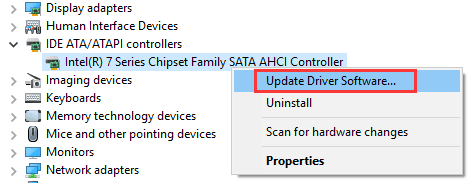

(and no, Windows didn't get a chance to download the driver before I checked if it was usable).īut for this one, it doesn't keep any specific ports out of RAID mode, and there's no way to individually set ports in AHCI mode while others are in RAID mode.
#Raid drivers for windows 10 install
Was able to install RAID driver afterwards, but the RAID volume itself was even available for access before having the driver. By that, I mean Windows was already installed on the harddrive and the system was in AHCI mode, then I switched it over to RAID mode in BIOS, configured the RAID on my other 4 drives, and booted into Windows. I set it up with a similar process of how I'm doing this one. SanDisk Ultra II 256GB SSD - Windows 10 OS, GPT with UEFI bootĤx Seagate ST32000646NS 2TB HDDs - RAID 0 The way it worked, while four of the five SATA ports were in RAID mode, the fifth port was still in AHCI mode. Motherboard was an ASRock 990FX Extreme 3. I am desperately trying to avoid reinstalling Windows just to have the RAID driver installed from the start, and I'd rather not do a software RAID (Windows "Striped Volume").ĭo we have any suggestions or things that I can do to get this done? Or some workaround that gets that same thing done. So here's what I need - I need to be able to install the SATA RAID driver for my x399 without the system being in RAID mode. Then I download the actual chipset drivers and display drivers and download and install them and reboot, then try the SATA RAID driver installer again, and its a no-go, still only gives me options for display drivers. I go to download the SATA RAID drivers from the AMD chipset drivers page for the x399, and when I run the installer. So I switch it back to AHCI and boot Windows, YAY. Pulled the SSD over to the old motherboard and attempted to enable Safe boot before bringing it over, to see if I could safe boot with RAID mode on - turns out, I could not. So I tried to boot Windows after configuring the RAID 0 on the other four drives and, lo and behold, Blue screens "Inaccessible Boot device" This new motherboard does not appear to have that lucky setting - either all drives are in RAID mode (though not all need to be in a RAID, of course), or all drives are not. The old motherboard luckily had only 4 of the SATA ports capable of RAID, the fifth was held out of RAID configuration. Now on my old motherboard, I had 4 SATA HDDs in RAID 0 and then my SATA SSD as the main OS drive. So I recently decided to upgrade to the Threadripper series, getting the 1900 and an Asus Prime X399-A to go with it.


 0 kommentar(er)
0 kommentar(er)
